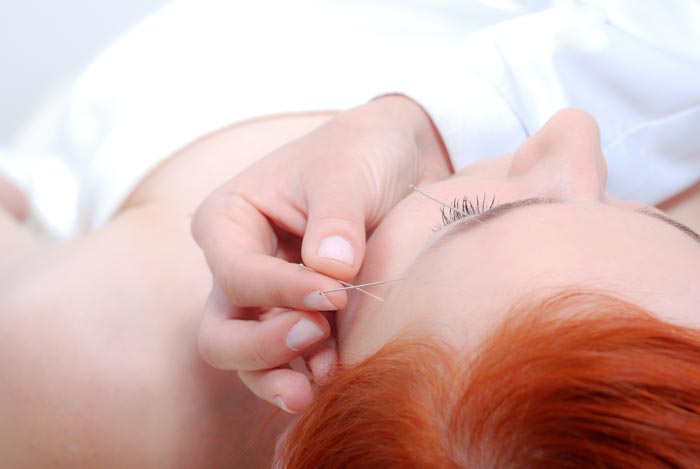Acupuncture relieves dry eyes by increasing tear secretion and stability, reducing tear film break-up, and preventing ocular damage.
Researchers find acupuncture safe and effective for the treatment of dry eyes. In a controlled study, investigators demonstrate that acupuncture significantly enhances the rate of positive patient outcomes for patients using lubricant eye drops for dry eye syndrome. Patients receiving acupuncture plus eye drops had a 76.92% total effective rate. Patients receiving only eye drops had a 53.85% total effective rate.

Research published in the Chinese Journal of Practical Ophthalmology finds acupuncture effective for the treatment of dry eye syndrome (keratoconjunctivitis sicca). Huang et al. compared patients receiving acupuncture and lubricant eye drops with patients receiving only lubricant eye drops. Patients receiving acupuncture treatments had significantly greater positive patient outcomes. Acupuncture increased lacrimal gland secretion, improved tear film stability, and slowed tear film breakdown.
Patients receiving acupuncture plus lubricant eye drops had a 76.92% improvement rate in dry eye symptoms. Patients receiving only lubricant eye drops had a 53.85% improvement rate. Tear film stability improved significantly with acupuncture. Patients receiving acupuncture plus eye drops had a tear film break-up time of 4.03 seconds compared with 2.11 seconds for the eye drop only group. Acupuncture achieved similar results in producing increased tear secretions. Acupuncture plus eye drops patients had a Schirmer I Test (SIT) value of 5.13 mm compared with 3.46 mm for the eye drop only group. In addition, acupuncture prevented ocular surface damage. The acupuncture plus eye drop group had a lower corneal fluorescein staining (FL) score of 1.05 compared with 1.31 for the group receiving only eye drops.
Dry eye occurs when there is dysfunction in tear production, tear consistency, or when tears evaporate too quickly. This often leads to inflammation of the eye surface, which may cause pain, scarring of the cornea, vision loss, and ulcerations. There are two main causes of dry eye syndrome. The first is due to insufficient production of the watery aspect of tears by the lacrimal glands. Another variety is due to meibomian gland inflammation. These are large sebaceous glands of the eyelids that form the oily part of tears, thereby slowing evaporation and promoting tear stability. Inflammation of these glands inhibits their normal functioning.
Inclusion criteria for the study included middle-aged patients diagnosed with dry eye syndrome. The acupuncture treatment group received lubricant eye drops and acupuncture treatments for ten acupuncture sessions. Each acupuncture session was twenty minutes and they were administered once every two days. The control group received only lubricant eye drops. Lubricant eye drops were administered in both groups, four times per day. The following primary acupuncture points were needled bilaterally:
- Jingming (BL1)
- Zanzhu (BL2)
- Taiyang (MHN9)
- Sibai (ST2)
- Hegu (LI4)
- Sanyinjiao (SP6)
- Fengchi (GB20)
- Taixi (KD3)
The results of the protocolized investigation demonstrate that acupuncture enhances the efficacy of dry eye syndrome treatment. Specifically, acupuncture increases positive outcomes for patients using lubricant eye drops. This groundbreaking research opens important avenues to produce further research and subsequent metanalyses.

Dry eye syndrome treatment is often viewed according to Traditional Chinese Medicine (TCM) principles as resulting from excess heat combined with a yin and yang imbalance of internal organs, which leads to insufficient nourishment and inflammation of the eyes and eyelids. Biomedical correlates are inflammatory conditions, hormonal imbalances, and related disorders. A guiding TCM principle is to nourish the blood and to improve qi and blood circulation to the eyes. Especially in cases of external pernicious influences, expelling wind is of importance.
Acupoints selections for the study were based on common usage within the acupuncturist profession, including the following acupoints: Jingming, Taiyang, Zanzhu, Sibai, Fengchi, Sanyinjiao. The Jingming acupoint is located on the inner canthus region and is part of the Taiyang bladder meridian. It is also the intersection acupoint of the Taiyang meridian and the Yangming stomach meridian. It removes excess wind and heat, and stimulates qi and blood circulation to the eyes. The Zanzhu acupoint is located on the supraorbital foramen. It removes excess wind. The Sibai acupoint is located on the infraorbital foramen region and it improves general ocular qi and blood circulation. The Taiyang acupoint is located between the brow tip and outer canthus. The Fengchi acupoint is located at the intersection of the Shaoyang gallbladder meridian and Yangwei meridians. Both Taiyang and Fengchi promote ocular health. In particular, Fengchi removes excess wind from the liver. The Sanyinjiao acupoint nourishes the blood and dredges meridians, which in turn nourishes the eyes.
Dry eye syndrome causes patient discomfort and may lead to loss of vision. As a result, effective protocols of care are very important. This integrative medicine approach demonstrates a significant improvement in outcomes. The researchers definitively conclude that acupuncture enhances the clinical efficacy of dry eye lubricants for patients with dry eye syndrome. Based on these findings, additional research is recommended.
References:
Huang J, Zhao J, Xu H, Lu H & Liu Y. (2012). Clinical observation on treating dry eye by acupuncture. Chinese Journal of Practical Ophthalmology (CJPO). 30(5).
Lemp M, Baudouin C, Baum J, et al. (2007). The definition and classification of dry eye disease: report of the Definition and Classification Subcommittee of the International [J]. Dry Eye Workshop. 5(2): 75-92.


